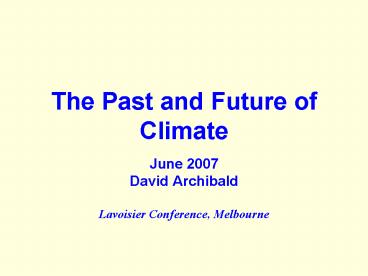The Past and Future of Climate - PowerPoint PPT Presentation
Title:
The Past and Future of Climate
Description:
Accumulated Number of Spotless Days Solar Cycles 10 to 15 compared to Solar Cycles 16 to 23 ... and it will be colder next decade by 2.0 degrees centigrade. ... – PowerPoint PPT presentation
Number of Views:74
Avg rating:3.0/5.0
Title: The Past and Future of Climate
1
The Past and Future of Climate
- June 2007
- David Archibald
- Lavoisier Conference, Melbourne
2
The 28 years of High Quality Satellite Data
Global
Northern Hemisphere
Southern Hemisphere
The Southern Hemisphere is the same temperature
it was 28 years ago, the Northern Hemisphere has
warmed slightly.
3
A Rural US Data Set
The smoothed average annual temperature of the
Hawkinsville (32.3N, 83.5W), Glennville (31.3N,
89.1W), Calhoun Research Station (32.5N, 92.3W),
Highlands (35.0N, 82.3W) and Talbotton (32.7N,
84.5W) stations is representative of the US
temperature profile away from the urban heat
island effect over the last 100 years (Data
source NASA GISS)
4
A 300 Year Thermometer RecordCentral England
Temperature
5
Medieval Warm Period Little Ice Age
6
IPCC Chart
7
The Holocene Optimum
8
The Ice Ages
9
Ice Ages The Longer Term Record
10
Climate over Geologic Time
11
The Solar Driver
12
The Dalton Minimum at Three European Stations
1770 to 1840
13
Sunspot Cycle Length Relative to Temperature De
Bilt, Netherlands 1705 - 2000
14
Sunspot Cycle Length Relative to Temperature
Armagh, Northern Ireland 1796 1992
Solar Cycle 22
Solar Cycle 23
15
The Transition from Solar Cycle 22 to Solar Cycle
23
16
Progression of Solar Cycles 19 - 23
Smoothed Wolf Number
Source Jan Janssens, Belgian Solar Section
17
Accumulated Number of Spotless Days Solar
Cycles 10 to 15 compared to Solar Cycles 16 to 23
Source Jan Janssens, Belgian Solar Section
18
NASAs Solar Minimum Prediction
- March, 2008 (6 months)
- Marks the end of Cycle 23 and start of Cycle 24
- The length of Cycle 23 will then be 11.75 years
- due to the absence of expected signatures of
minimum-like conditions in March, 2007 - no high-latitude sunspots yet observed with the
Cycle 24 polarity - the large scale corona has not yet relaxed to a
simple dipole - the heliospheric current sheet has not yet
flattened - activity measures, e.g. cosmic ray flux, radio
flux, and sunspot number, have not yet reached
typical solar minimum values - Released on 25th April, 2007
- NASA really dont know, but as they are supposed
to know, they have to say something.
Source http//www.sec.noaa.gov/SolarCycle/SC24/B
iesecker.ppt
19
Predictions of Solar Cycle 24
20
The Solar Dynamo Index
21
Projected Temperature Profile to 2030
22
Another Dalton Minimum, or Worse?
- The surprising result of these long-range
predictions is a rapid decline in solar activity,
starting with cycle 24. If this trend continues,
we may see the Sun heading towards a Maunder
type of solar activity minimum - an extensive
period of reduced levels of solar activity. - K.H.Schatten and W.K.Tobiska, 34th Solar Physics
Division Meeting, June 2003, American
Astronomical Society
23
aa Index
1970s Cooling Scare
20th Century Warming Period
Little Ice Age
24
Galactic Cosmic Rays
1970s Cooling Scare
Solar Cycle 20 Maximum
Solar Cycle 23 Maximum
Solar Cycle 21 Maximum
Solar Cycle 19 Maximum
Solar Cycle 22 Maximum
25
The Warming Effect of Atmospheric Carbon Dioxide
26
Relative Contributions of Pre-Industrial and
Anthropogenic CO2
620 1000 ppm
380 620 ppm
Existing and Potential Anthropogenic
CO2 Greenhouse Effect
280 380 ppm
20 280 ppm
Pre-industrial CO2 Greenhouse Effect
0 20 ppm
27
The Temperature Increase Due to Increased
Atmospheric Carbon Dioxide
28
Historic and Projected Atmospheric Carbon
Contributions by the United States, China and
Australia
29
The Anthropogenic Contribution
30
Can Carbon Dioxide be even a little bit bad?
31
Average Growth Enhancement due to a 300 ppm
increase in atmospheric carbon dioxide
Source Idso May 2007
32
Stressed relative to unstressed plant response
33
Summary
- The Sun drives climate change and it will be
colder next decade by 2.0 degrees centigrade. - The anthropogenic carbon dioxide effect is real,
minuscule and too small to be measured. - Higher atmospheric carbon dioxide levels will
boost agricultural production. - Increased atmospheric carbon dioxide is wholly
beneficial.































